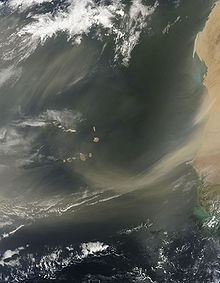
| Granulometry | |
|---|---|
 | |
| Basic concepts | |
| Particle size, Grain size, Size distribution, Morphology | |
| Methods and techniques | |
| Mesh scale, Optical granulometry, Sieve analysis, Soil gradation | |
Related concepts | |
| Granulation, Granular material, Mineral dust, Pattern recognition, Dynamic light scattering | |
Mineral dust is atmospheric aerosol originated from the suspension of minerals constituting the soil, composed of various oxides and carbonates. Human activities lead to 25% of the airborne dust (particulates) load in the atmosphere. The Sahara Desert is the major source of mineral dust, which subsequently spreads across the Mediterranean (where it is the origin of rain dust) and Caribbean seas into northern South America, Central America, and eastern North America, and Europe. Additionally, it plays a significant role in the nutrient inflow to the Amazon rainforest. The Gobi Desert is another source of dust in the atmosphere, which affects eastern Asia and western North America.
Characteristics
Mineral dust is mainly constituted of the oxides (SiO2, Al2O3, FeO, Fe2O3, CaO, and others) and carbonates (CaCO3, MgCO3) that constitute the Earth's crust. The composition of mineral dust, usually named in atmospheric sciences as mineralogy composition, is relevant for different physical and chemical processes in the atmosphere, for example, oxides with iron have an effect in the optical properties with impact in climate, while minor components can modify the role in the atmosphere of mineral dust as cloud condensation nuclei.
Global mineral dust emissions are estimated at 1000-5000 million tons per year, of which the largest part is attributed to deserts. Although this aerosol class is usually considered of natural origin, it is estimated that about a quarter of mineral dust emissions could be ascribed to human activities through desertification and land use changes. Recent studies highlight that the fraction of large particles (called coarse dust) may be higher than previously thought and total emissions would be therefore also higher.
Large dust concentrations may cause problems to people having respiratory problems. Another effect of dust clouds is more colorful sunsets.
Saharan dust
Main article: Saharan dust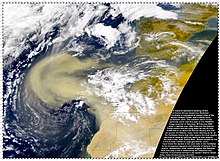
The Sahara is the major source on Earth of mineral dust (60-200 million tons per year). Saharan dust can be lifted by convection over hot desert areas, and can thus reach very high altitudes; from there it can be transported worldwide by winds, covering distances of thousands of kilometers. The dust combined with the extremely hot, dry air of the Sahara Desert often forms an atmospheric layer called the Saharan Air Layer which has significant effects on tropical weather, especially as it interferes with the development of hurricanes.
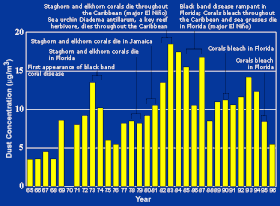
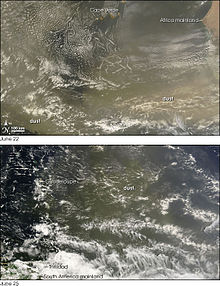
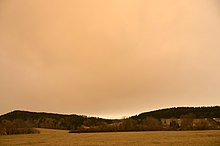
There is a large variability in the dust transport across the Atlantic into the Caribbean and Florida from year to year. In some years African dust is observed along much of the East Coast of the United States and is visible in the sky. Due to the trade winds, very large concentrations of mineral dust can be found in the tropical Atlantic, reaching the Caribbean; moreover episodic transport to the Mediterranean region. Saharan plumes can form iberulites (a particular tropospheric aggregation of aerosols) when these plumes travel through North Africa and the eastern North Atlantic Ocean, and often reach the circum-Mediterranean areas of Western Europe. In the Mediterranean region, Saharan dust is important as it represents the major source of nutrients for phytoplankton and other aquatic organisms. Saharan dust carries the fungus Aspergillus sydowii and others. Aspergillus borne by Saharan dust falls into the Caribbean Sea and possibly infects coral reefs with Sea Fan disease (aspergillosis). It also has been linked to increased incidence of pediatric asthma attacks in the Caribbean. Since 1970, dust outbreaks have worsened due to periods of drought in Africa. Dust events have been linked to a decline in the health of coral reefs across the Caribbean and Florida, primarily since the 1970s.
Effect on hurricane frequency
According to a NASA article, NASA satellites have shown that "the chilling effect of dust was responsible for one-third of the drop in North Atlantic sea surface temperatures between June 2005 and 2006, possibly contributing to the difference in hurricane activity between the two seasons." There were only 5 hurricanes in 2006 compared with 15 in 2005.
It is known that one of the major factors that create hurricanes is warm water temperatures on the surface of the ocean. Evidence shows that dust from the Sahara desert caused surface temperatures to be cooler in 2006 than in 2005.
Asian dust
Main article: Asian dust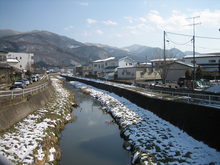
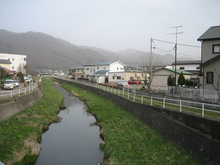
In Eastern Asia, mineral dust events that originate in the Gobi Desert (Southern Mongolia and Northern China) during springtime give rise to the phenomenon called Asian dust. The aerosols are carried eastward by prevailing winds, and pass over China, Korea, and Japan. Sometimes, significant concentrations of dust can be carried as far as the Western United States. Areas affected by Asian dust experience decreased visibility and health problems, such as sore throat and respiratory difficulties. The effects of Asian dust, however, are not strictly negative, as it is thought that its deposition enriches the soil with important trace minerals.
An American study analyzing the composition of Asian dust events reaching Colorado associates them to the presence of carbon monoxide, possibly incorporated in the air mass as it passes over industrialized regions in Asia. Although dust storms in the Gobi desert have occurred from time to time throughout history, they became a pronounced problem in the second half of the 20th century due to intensified agricultural pressure and desertification.
North American dust
Mineral dust originates from several sources on the North American continent including the Southwest, the Great Plains, and Alaska. In the Southwest, dust impacts human health, visibility, lake productivity, and the rate of snowmelt in the Rocky Mountains. Dust deposition has increased dramatically since the early 1800s compared to the natural background due to the intensification of human activities.
Relationship to drought
Arid and semi-arid regions are naturally prone to dust emissions. Soil moisture is an important variable controlling dust emissions, along with vegetation cover, wind speed and soil type. Several studies based on modern observations show positive relationships (i.e. increasing drought increases dust) between dust and drought conditions in each dust cycle phase, from emissions, to atmospheric burden, to deposition. However, studies based on paleo records of dust deposition (e.g. using lake sediment) that specifically looked at megadroughts show both increases and no change in dust deposition. The study by Routson showed an increase in deposition during megadroughts but used a measure of dust concentration rather than accumulation that is affected by the rate of sedimentation. The Routson study instead used dust accumulation rates and found no difference between dust deposition during drought years and megadroughts and deposition during normal hydroclimate conditions. Instead, they found that dust deposition is more likely controlled by transport mechanisms and sediment supply than by hydroclimate. Similarly, Arcusa found no evidence for higher dust deposition during drought on multi-decadal and centennial scales. They also found that sediment supply played a key role as evidenced from a 60% increase in deposition in the 1800s due to accelerating land disturbance.
See also
- Azores High
- Canary Current
- Dust storm
- Dust Bowl
- Dust devil
- Iberulites
- Iron fertilization
- Sahel
- Western Hemisphere Warm Pool
References
- Ginoux, Paul; Prospero, Joseph M.; Gill, Thomas E.; Hsu, N. Christina; Zhao, Ming (September 2012). "Global-scale attribution of anthropogenic and natural dust sources and their emission rates based on MODIS Deep Blue aerosol products". Reviews of Geophysics. 50 (3). Bibcode:2012RvGeo..50.3005G. doi:10.1029/2012RG000388. ISSN 8755-1209.
- Checa-Garcia, Ramiro; Balkanski, Yves; Albani, Samuel; Bergman, Tommi; Carslaw, Ken; Cozic, Anne; Dearden, Chris; Marticorena, Beatrice; Michou, Martine; van Noije, Twan; Nabat, Pierre; O'Connor, Fiona M.; Olivié, Dirk; Prospero, Joseph M.; Le Sager, Philippe (2021-07-08). "Evaluation of natural aerosols in CRESCENDO Earth system models (ESMs): mineral dust". Atmospheric Chemistry and Physics. 21 (13): 10295–10335. Bibcode:2021ACP....2110295C. doi:10.5194/acp-21-10295-2021. ISSN 1680-7316.
- Koren, I.; Kaufman, Y. J.; Washington, R.; Todd, M. C.; Rudich, Y.; Martins, J. V.; Rosenfeld, D. (2006). "The Bodélé depression: a single spot in the Sahara that provides most of the mineral dust to the Amazon forest". Environmental Research Letters. 1 (1): 014005. Bibcode:2006ERL.....1a4005K. doi:10.1088/1748-9326/1/1/014005.
- Shao, Yaping; Wyrwoll, Karl-Heinz; Chappell, Adrian; Huang, Jianping; Lin, Zhaohui; McTainsh, Grant H.; Mikami, Masao; Tanaka, Taichu Y.; Wang, Xulong; Yoon, Soonchang (March 2011). "Dust cycle: An emerging core theme in Earth system science". Aeolian Research. 2 (4): 181–204. Bibcode:2011AeoRe...2..181S. doi:10.1016/j.aeolia.2011.02.001.
- Sand, Maria; Samset, Bjørn H.; Myhre, Gunnar; Gliß, Jonas; Bauer, Susanne E.; Bian, Huisheng; Chin, Mian; Checa-Garcia, Ramiro; Ginoux, Paul; Kipling, Zak; Kirkevåg, Alf; Kokkola, Harri; Le Sager, Philippe; Lund, Marianne T.; Matsui, Hitoshi (2021-10-26). "Aerosol absorption in global models from AeroCom phase III". Atmospheric Chemistry and Physics. 21 (20): 15929–15947. Bibcode:2021ACP....2115929S. doi:10.5194/acp-21-15929-2021. ISSN 1680-7316.
- Jin, Qinjian; Yang, Zong-Liang; Wei, Jiangfeng (2016-07-28). "High sensitivity of Indian summer monsoon to Middle East dust absorptive properties". Scientific Reports. 6 (1): 30690. Bibcode:2016NatSR...630690J. doi:10.1038/srep30690. ISSN 2045-2322. PMC 4964619. PMID 27465689.
- Kelly, James T.; Chuang, Catherine C.; Wexler, Anthony S. (2007-05-01). "Influence of dust composition on cloud droplet formation". Atmospheric Environment. 41 (14): 2904–2916. Bibcode:2007AtmEn..41.2904K. doi:10.1016/j.atmosenv.2006.12.008. ISSN 1352-2310.
- Huneeus, N.; Schulz, M.; Balkanski, Y.; Griesfeller, J.; Prospero, J.; Kinne, S.; Bauer, S.; Boucher, O.; Chin, M.; Dentener, F.; Diehl, T.; Easter, R.; Fillmore, D.; Ghan, S.; Ginoux, P.; Grini, A.; Horowitz, L.; Koch, D.; Krol, M. C.; Landing, W.; Liu, X.; Mahowald, N.; Miller, R.; Morcrette, J. -J.; Myhre, G.; Penner, J.; Perlwitz, J.; Stier, P.; Takemura, T.; Zender, C. S. (2011). "Global dust model intercomparison in Aero Com phase I". Atmospheric Chemistry and Physics. 11 (15): 7781. Bibcode:2011ACP....11.7781H. doi:10.5194/acp-11-7781-2011. hdl:11858/00-001M-0000-0012-1B7F-5.
- Ginoux, P.; Prospero, J. M.; Gill, T. E.; Hsu, N. C.; Zhao, M. (2012). "Global-scale attribution of anthropogenic and natural dust sources and their emission rates based on MODIS Deep Blue aerosol products". Reviews of Geophysics. 50 (3): RG3005. Bibcode:2012RvGeo..50.3005G. CiteSeerX 10.1.1.295.2808. doi:10.1029/2012RG000388. S2CID 14181456.
- Kok, Jasper F.; Adebiyi, Adeyemi A.; Albani, Samuel; Balkanski, Yves; Checa-Garcia, Ramiro; Chin, Mian; Colarco, Peter R.; Hamilton, Douglas S.; Huang, Yue; Ito, Akinori; Klose, Martina; Li, Longlei; Mahowald, Natalie M.; Miller, Ron L.; Obiso, Vincenzo (2021-05-27). "Contribution of the world's main dust source regions to the global cycle of desert dust". Atmospheric Chemistry and Physics. 21 (10): 8169–8193. Bibcode:2021ACP....21.8169K. doi:10.5194/acp-21-8169-2021. ISSN 1680-7316.
- Adebiyi, Adeyemi; Kok, Jasper F.; Murray, Benjamin J.; Ryder, Claire L.; Stuut, Jan-Berend W.; Kahn, Ralph A.; Knippertz, Peter; Formenti, Paola; Mahowald, Natalie M.; Pérez García-Pando, Carlos; Klose, Martina; Ansmann, Albert; Samset, Bjørn H.; Ito, Akinori; Balkanski, Yves (2023-01-01). "A review of coarse mineral dust in the Earth system". Aeolian Research. 60: 100849. Bibcode:2023AeoRe..6000849A. doi:10.1016/j.aeolia.2022.100849. ISSN 1875-9637.
- "Earth from Space: Sahara sand". www.esa.int. 2010-09-10. Retrieved 2024-10-15.
- Stuut,J-B.,Smalley,I.J.,O'Hara-Dhand,K. 2009. Aeolian dust in Europe: African sources and European deposits. Quaternary International 198, 234-245. doi:10.1016/j.quaint 2008.10.007.
- Schlesinger, P.; Mamane, Y.; Grishkan, I. (2006). "Transport of microorganisms to Israel during Saharan dust events". Aerobiologia. 22 (4): 259. Bibcode:2006Aerob..22..259S. doi:10.1007/s10453-006-9038-7. S2CID 84442418. "On a spring clear day, the persisting airborne fungi were Alternaria alternata, Geotrichum candidum, Penicillium chrysogenum, and P. glabrum. However, during two dust events the fungal population was dominated by Alternaria alternata, Aspergillus fumigatus, A. niger, A. thomii, Cladosporium cladosporioides, Penicillium chrysogenum, and P. griseoroseum. This study suggests that Saharan and other desert dust events in the East Mediterranean have a significant effect on the airborne microbial populations, which might impact on health, agriculture, and ecology."
- Usinfo.state.gov. Study Says African Dust Affects Climate in U.S., Caribbean. Archived 2007-06-20 at the Wayback Machine Retrieved on 2007-06-10.
- "Coral Mortality and African Dust". U. S. Geological Survey. December 6, 2006. Archived from the original on Oct 6, 2007. Retrieved 2007-06-10.
- Hansen, Kathryn (December 17, 2007). "Sharan Dust has chilling effect on North Atlantic". NASA. Archived from the original on 2017-05-31. Retrieved 2008-01-08.
- O'Brien, Dennis (June 24, 2005). "Blowing in the Wind". The Baltimore Sun. Archived from the original on Oct 6, 2007. Retrieved 2007-06-10 – via University of Utah Department of Meteorology.
- DeBell, Linsey J.; Vozzella, Marcy; Talbot, Robert W.; Dibb, Jack E. (2004-01-16). "Asian dust storm events of spring 2001 and associated pollutants observed in New England by the Atmospheric Investigation, Regional Modeling, Analysis and Prediction (AIRMAP) monitoring network". Journal of Geophysical Research: Atmospheres. 109 (D1). Bibcode:2004JGRD..109.1304D. doi:10.1029/2003JD003733. ISSN 0148-0227.
- Tong, Daniel Q.; Wang, Julian X. L.; Gill, Thomas E.; Lei, Hang; Wang, Binyu (2017-05-16). "Intensified dust storm activity and Valley fever infection in the southwestern United States: Dust and Valley Fever Intensification". Geophysical Research Letters. 44 (9): 4304–4312. doi:10.1002/2017GL073524. PMC 6108409. PMID 30166741.
- Goudie, Andrew S. (February 2014). "Desert dust and human health disorders". Environment International. 63: 101–113. Bibcode:2014EnInt..63..101G. doi:10.1016/j.envint.2013.10.011. PMID 24275707. Archived from the original on 2020-08-18. Retrieved 2019-12-03.
- Trijonis, John (January 1979). "Visibility in the southwest—An exploration of the historical data base". Atmospheric Environment. 13 (6): 833–843. Bibcode:1979AtmEn..13..833T. doi:10.1016/0004-6981(79)90274-9.
- Li, Junran; Kandakji, Tarek; Lee, Jeffrey A.; Tatarko, John; Blackwell, John; Gill, Thomas E.; Collins, Joe D. (April 2018). "Blowing dust and highway safety in the southwestern United States: Characteristics of dust emission "hotspots" and management implications". Science of the Total Environment. 621: 1023–1032. Bibcode:2018ScTEn.621.1023L. doi:10.1016/j.scitotenv.2017.10.124. PMID 29102198.
- Ballantyne, A. P.; Brahney, J.; Fernandez, D.; Lawrence, C. L.; Saros, J.; Neff, J. C. (2011-09-23). "Biogeochemical response of alpine lakes to a recent increase in dust deposition in the Southwestern, US". Biogeosciences. 8 (9): 2689–2706. Bibcode:2011BGeo....8.2689B. doi:10.5194/bg-8-2689-2011. ISSN 1726-4189.
- Painter, Thomas H.; Skiles, S. McKenzie; Deems, Jeffrey S.; Brandt, W. Tyler; Dozier, Jeff (2018-01-28). "Variation in Rising Limb of Colorado River Snowmelt Runoff Hydrograph Controlled by Dust Radiative Forcing in Snow". Geophysical Research Letters. 45 (2): 797–808. Bibcode:2018GeoRL..45..797P. doi:10.1002/2017GL075826. S2CID 134958509.
- Neff, J. C.; Ballantyne, A. P.; Farmer, G. L.; Mahowald, N. M.; Conroy, J. L.; Landry, C. C.; Overpeck, J. T.; Painter, T. H.; Lawrence, C. R. (March 2008). "Increasing eolian dust deposition in the western United States linked to human activity". Nature Geoscience. 1 (3): 189–195. Bibcode:2008NatGe...1..189N. doi:10.1038/ngeo133. ISSN 1752-0894. S2CID 10132569.
- ^ Routson, Cody C.; Arcusa, Stéphanie H.; McKay, Nicholas P.; Overpeck, Jonathan T. (2019-07-19). "A 4,500-Year-Long Record of Southern Rocky Mountain Dust Deposition". Geophysical Research Letters. 46 (14): 8281–8288. Bibcode:2019GeoRL..46.8281R. doi:10.1029/2019GL083255. hdl:2027.42/151372. ISSN 0094-8276. S2CID 198396202.
- ^ Routson, Cody C.; Overpeck, Jonathan T.; Woodhouse, Connie A.; Kenney, William F. (2016-02-17). Zhu, Liping (ed.). "Three Millennia of Southwestern North American Dustiness and Future Implications". PLOS ONE. 11 (2): e0149573. Bibcode:2016PLoSO..1149573R. doi:10.1371/journal.pone.0149573. ISSN 1932-6203. PMC 4757576. PMID 26886350.
- Abruzzi, William S. (1995-03-01). "The social and ecological consequences of early cattle ranching in the Little Colorado River Basin". Human Ecology. 23 (1): 75–98. Bibcode:1995HumEc..23...75A. doi:10.1007/BF01190099. ISSN 1572-9915. S2CID 154833651.
- Pye, K. (1987). Aeolian Dust and Dust Deposits. London: Academic Press. pp. 63–91. ISBN 978-0-12-568690-7.
- Okin, Gregory S.; Reheis, Marith C. (May 2002). "An ENSO predictor of dust emission in the southwestern United States: AN ENSO PREDICTOR OF DUST EMISSION". Geophysical Research Letters. 29 (9): 46–1–46-3. doi:10.1029/2001GL014494. S2CID 129866494.
- Achakulwisut, Pattanun; Shen, Lu; Mickley, Loretta J. (2017-11-27). "What Controls Springtime Fine Dust Variability in the Western United States? Investigating the 2002-2015 Increase in Fine Dust in the U.S. Southwest: Controlling factors of western U.S. dust". Journal of Geophysical Research: Atmospheres. 122 (22): 12, 449–12, 467. doi:10.1002/2017JD027208. S2CID 102488347.
- Reheis, Marith C.; Urban, Frank E. (June 2011). "Regional and climatic controls on seasonal dust deposition in the southwestern U.S." Aeolian Research. 3 (1): 3–21. Bibcode:2011AeoRe...3....3R. doi:10.1016/j.aeolia.2011.03.008.
- ^ Arcusa, Stephanie H; McKay, Nicholas P; Routson, Cody C; Munoz, Samuel E (2019-09-18). "Dust-drought interactions over the last 15,000 years: A network of lake sediment records from the San Juan Mountains, Colorado". The Holocene. 30 (4): 559–574. doi:10.1177/0959683619875192. ISSN 0959-6836. S2CID 220596313.
- Kubilay and Saydam, "Trace elements in atmospheric particulates over the Eastern Mediterranean: concentration, sources, and temporal variability", Atmospheric Environment 29, 2289-2300 (1995).
- Morales, "The airborne transport of Saharan dust: a review", Climate Change 9, 219-241 (1986).
- Loyë-Pilot et al., "Influence of Saharan dust on the rain acidity and atmospheric input to the Mediterranean", Nature 321, 427-428 (1986).
- Sokolik and Toon, "Direct radiative forcing by anthropogenic airborne mineral aerosols", Nature 381, 681-683 (1996).
- Tegen and Fung, "Contribution to the atmospheric mineral aerosol load from land surface modification", Journal of Geophysical Research 100, 18707-18726 (1995).
External links
- The Dust Hypothesis for Caribbean Coral Bleaching as reported by the United States Geological Survey
- Saharan dust in America Archived 2007-09-29 at the Wayback Machine
- High quality video of dust from Sahara to Amazon